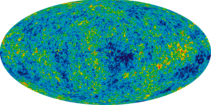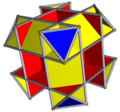| Revision as of 11:11, 25 January 2015 editTomruen (talk | contribs)Autopatrolled, Extended confirmed users, Pending changes reviewers119,883 edits →cube truncations← Previous edit | Revision as of 13:00, 31 January 2015 edit undoTomruen (talk | contribs)Autopatrolled, Extended confirmed users, Pending changes reviewers119,883 edits →Warring and warningNext edit → | ||
| (One intermediate revision by one other user not shown) | |||
| Line 88: | Line 88: | ||
| ::Of course they're real. Do you mean Coxeter mentions the entire sequence, but without the names like hyper- and antitruncation? ] (]) 07:34, 25 January 2015 (UTC) | ::Of course they're real. Do you mean Coxeter mentions the entire sequence, but without the names like hyper- and antitruncation? ] (]) 07:34, 25 January 2015 (UTC) | ||
| ::: Nope, not to my knowledge. I just made visualizations of what was described on the wikipedia page. So the hyper-,anti- truncated forms, even if vertex-transitive are not mentioned apparently because they can't generate uniform (equal edge-length) solutions. ] (]) 11:11, 25 January 2015 (UTC) | ::: Nope, not to my knowledge. I just made visualizations of what was described on the wikipedia page. So the hyper-,anti- truncated forms, even if vertex-transitive are not mentioned apparently because they can't generate uniform (equal edge-length) solutions. ] (]) 11:11, 25 January 2015 (UTC) | ||
| == Warring and warning == | |||
| '''WARNING''' Tom, I am not sure what has got into you today but your community skills seem to have exploded. You are warring at ] and now ], despite your long experience you profess no knowledge of basic ] such as when to discuss and how not to upset, you treat policy as nonsense when it suits you. If you do not calm down I shall take this to ]. — Cheers, ] (]) 12:58, 31 January 2015 (UTC) | |||
| : It's your interpretation. ] (]) 13:00, 31 January 2015 (UTC) | |||
Revision as of 13:00, 31 January 2015
| This is Tomruen's talk page, where you can send him messages and comments. |
|
|
Archives |
| Please leave a new message. |
Invitation

|
You've been invited to be part of WikiProject Cosmology |
|
Hello. Your contributions to Misplaced Pages have been analyzed carefully and you're among the few chosen to have a first access to a new project. I hope you can contribute to it by expanding the main page and later start editing the articles in its scope. Make sure to check out the Talk page for more information! Cheers |
Nets for Geodestic spheres
Hi, Im new to wikipedia and just looking around I noticed you have really amazing. I was looking at this page User:Tomruen/Geodestic_sphere and i was wondering if there was a 2d Net somewhere for those shapes. Like someone thing you could theoretically print out on a piece of paper and then fold into those shapes. — also I was wondering what program you were using to make those images.—thx — Preceding unsigned comment added by Jooe15 (talk • contribs) 02:32, 5 January 2015 (UTC)
Hi Jooe15, Thanks! Most I didn't do but I have software to make nets. This Free webpage generates polyhedra, and OBJ export. And not-free Stella (software) can draw nets of imported polyhedra. Which one are you interested in. Conway polyhedron notation is given on many at Goldberg polyhedron and Capsid. Tom Ruen (talk) 03:02, 5 January 2015 (UTC)
Johnson
Tom, you are plastering references to Johnson, Geometries and transformations (2015) across Misplaced Pages as fast as you can type. At present I can find no reference at all to this publication elsewhere, not Google, not Amazon, nada, zilch. There are just the old few references to the draft MS he circulated some years ago. What is your basis for all this? If it doesn't appear ASAP, you will have made a handsome mess. — Cheers, Steelpillow (Talk) 10:36, 6 January 2015 (UTC)
- I have a preprint PDF. It has been accepted for publication last September. Its a limited source for polytopes, but an extremely detailed source for Coxeter groups and subgroups and related terminology. I'll take responsibility if there's some delay for printing. Tom Ruen (talk) 10:39, 6 January 2015 (UTC)
- Um. I have asked the question at Wikipedia_talk:WikiProject_Mathematics#Citing_a_preprint. — Cheers, Steelpillow (Talk) 11:20, 6 January 2015 (UTC)
WikiProject Cosmology - task
I decided to drop you a message to make sure you check out the first task of the cosmology project: Help improve the Universe. Please feel free to remove this message after you read it :) Tetra quark (talk) 03:31, 7 January 2015 (UTC)
WikiProject Chemicals
Ah, thanks. I've tried to weed out whatever I can - I've removed a lot from the list as I've gone along - but things do slip through. Thanks for the heads-up. --Ser Amantio di NicolaoLo dicono a Signa. 08:41, 11 January 2015 (UTC)
cube truncations
It works with cantellation too! ;-) Double sharp (talk) 07:16, 24 January 2015 (UTC)
- You could analogically call the phases "cantellation" (rhombicuboctahedron), "complete cantellation" (octahedron), "hypercantellation" (unnamed), "complete hypercantellation" (degenerate, cube with hidden stuff inside), "quasicantellation" (great rhombicuboctahedron), complete quasicantellation (unnamed), and anticantellation (unnamed). Double sharp (talk) 07:20, 24 January 2015 (UTC)
- It looks fun. Tom Ruen (talk) 07:48, 24 January 2015 (UTC)
OK, how's this?
It would be better with a few more intermediate cases, though. Double sharp (talk) 11:04, 24 January 2015 (UTC)
- P.S. I'd love to see this applied to runcinating a tesseract, but by that point it might get visually really confusing. It would be really cool, though! Double sharp (talk) 11:06, 24 January 2015 (UTC)
It looks very nice, but we have no sources besides Bowers who uses his own terminology. Tom Ruen (talk) 11:09, 24 January 2015 (UTC)
- Wait, so the truncations are actually in Coxeter? That is really cool. Double sharp (talk) 13:14, 24 January 2015 (UTC)
- The truncations are real, but we need sources there too for terminology. Quasitruncation comes from Johnson at least. Tom Ruen (talk) 23:48, 24 January 2015 (UTC)
- Of course they're real. Do you mean Coxeter mentions the entire sequence, but without the names like hyper- and antitruncation? Double sharp (talk) 07:34, 25 January 2015 (UTC)
- Nope, not to my knowledge. I just made visualizations of what was described on the wikipedia page. So the hyper-,anti- truncated forms, even if vertex-transitive are not mentioned apparently because they can't generate uniform (equal edge-length) solutions. Tom Ruen (talk) 11:11, 25 January 2015 (UTC)
- Of course they're real. Do you mean Coxeter mentions the entire sequence, but without the names like hyper- and antitruncation? Double sharp (talk) 07:34, 25 January 2015 (UTC)
Warring and warning
WARNING Tom, I am not sure what has got into you today but your community skills seem to have exploded. You are warring at Star polytope and now Improper regular polygon, despite your long experience you profess no knowledge of basic WP:ETIQUETTE such as when to discuss and how not to upset, you treat policy as nonsense when it suits you. If you do not calm down I shall take this to WP:ANI. — Cheers, Steelpillow (Talk) 12:58, 31 January 2015 (UTC)
- It's your interpretation. Tom Ruen (talk) 13:00, 31 January 2015 (UTC)







